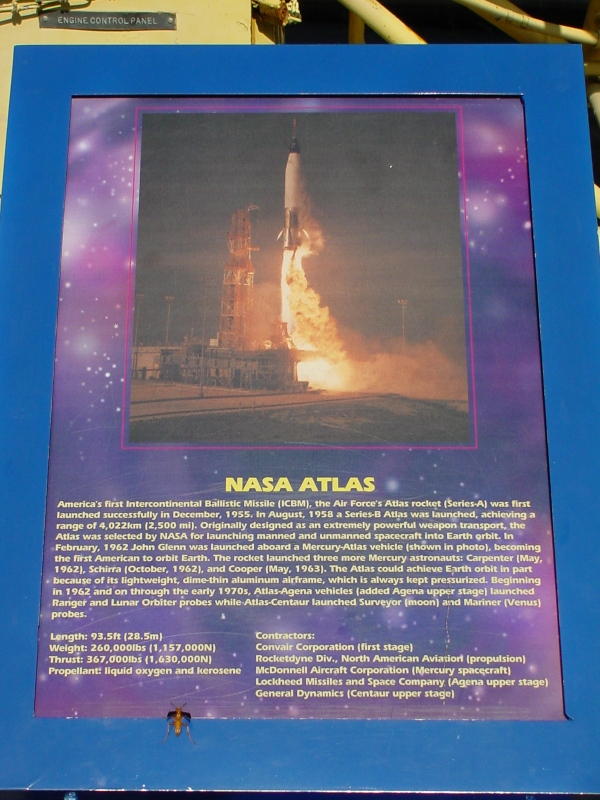| Prev |
heroicrelics.org U.S. Space & Rocket Center Site Index Atlas Gallery |
Next |
dsc00210.jpg
The sign accompanying the Atlas. It reads
NASA Atlas
America's first Intercontinental Ballistic Missile (ICBM), the Air Force's Atlas rocket (Series-A) was first launched successfully in December, 1955. In August, 1958 a Series-B Atlas was launched, achieving a range of 4,022km (2,500 mi). Originally designed as an extremely powerful weapon transport, the Atlas was selected by NASA for launching manned and unmanned spacecraft into Earth orbit. In February, 1962 John Glenn was launched aboard a Mercury-Atlas vehicle (shown in photo), becoming the American to orbit Earth. The rocket launched three more Mercury astronauts: Carpenter (May, 1962), Schirra (October, 1962), and Cooper (May, 1963). The Atlas could achieve Earth orbit in part because of its lightweight, dime-thin aluminum airframe, which is always kept pressurized. Beginning in 1962 and on through the early 1970s, Atlas-Agena vehicles (added Agena upper stage) launched Ranger and Lunar Orbiter probes while Atlas-Centaur launched Surveyor (moon) and Mariner (Venus) probes.
Weight: 93.5ft (28.5m) Contractors: Weight: 260,000lbs (1,157,000N) Convair Corporation (first stage) Thrust: 367,000lbs (1,630,000N) Rocketdyne Div., North American Aviation (propulsion) Propellant: liquid oxygen and kerosene McDonnell Aircraft Corporation (Mercury spacecraft) Lockheed Missiles and Space Company (Agena upper stage) General Dynamics (Centaur upper stage)
Of course, the "pound" is the Imperial measurement both for mass (lbm) and force (lbf) while the kilogram (kg) is the metric unit of mass and the newton (N) is the metric unit for force. So, while it's appropriate to convert pounds-force to newtons for thrust, the appropriate conversion for 260,000 pounds-mass would be to 117,934 kg.
Strictly speaking, the same company manufactured both the Atlas first stage and the Centaur upper stage; the two stages were designed by basically the same design team.
Things can get confused due to Convair's history: the Consolidated Aircraft Corporation (which manufactured, among other planes, the PBY Catalina and the B-24 Liberator) was eventually bought by Vultee Aircraft Corporation, becoming the Consolidated Vultee Aircraft Corporation, later shortened to "Convair." Convair itself was bought by General Dynamics.

| Time picture taken | Sat Jul 27 09:32:51 2002 |
| Location picture taken |
Rocket Park U.S. Space & Rocket Center Huntsville, AL |
| Prev |
heroicrelics.org U.S. Space & Rocket Center Site Index Atlas Gallery |
Next |